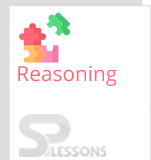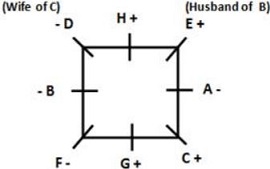 Introduction
Introduction
What is Reasoning Ability Test?
A logical reasoning test is a form of psychometric testing that is widely used by corporate employers to help assess candidates during their recruitment process. 'Psychometric' is just a fancy way of saying 'measuring mental ability' and logical reasoning tests are designed to measure your non-verbal skills.
The article SSC CPO Reasoning Ability Quiz 1 provides Reasoning Ability questions with answers useful to the candidates preparing for Competitive exams, Entrance exams, Interviews etc.
 Quiz
Quiz
Direction(1-5): Read the following information carefully and answer the given questions carefully.
A, B, C, D, E, F, G and H are sitting around a square table in such a way that four of them sit at four corners of the square while four sit in the middle of each of the four sides. The ones who sit at the four corners face the centre while those who sit in the middle of the sides face outside.
Two females sit in the middle of the sides and two at the corners. A sits second to the left of G. G sits in the middle of one of the sides. C sits fourth to the right of his wife and his wife is not an immediate neighbour of A or G. B sits third to right of her husband. B does not sit at any of the corners. Only D sits between B and H. H is the husband of A. E is a male.
1. Which of the following is true with respect to the given seating arrangement?
- A. No two males are immediate neighbors of each other.
B. G and H are diagonally opposite in the seating arrangement
C. E and D are immediate neighbours of each other
D. F is a male and sits diagonally opposite to E
E. A sits in the centre of one of the sides of the square table
- A. C
B. G
C. E
D. F
E. Cannot be Determined
- A. None
B. One
C. Two
D. Three
E. Four
- A. D
B. F
C. B
D. G
E. Cannot be determined
- A. Immediately to the left
B. Second to the right
C. Third to the right
D. Immediately to the right
E. Second to the left
Direction(1-5): In the following questions, the symbols @, ©, %, $ and ٭are used with the following meaning as illustrated below:
‘P © Q’ means ‘P is either equal to or greater than Q’.
‘P % Q’ means ‘P is smaller than Q’.
‘P * Q’ means ‘P is either equal to or smaller than Q’.
‘P @ Q’ means ‘P is greater than Q’.
‘P $Q’ means ‘P is equal to Q’.
Now in each of the following questions assuming the given statements to be true, find which of the two conclusions I and II given below them is/are definitely true.
1. Statement:
L* M, M $ N, N % K
Conclusion:
I. K @ L
II. L * N
- A. only Conclusion I is true.
B. only Conclusion II is true.
C. either Conclusion I or II is true.
D. neither Conclusion I nor II is true.
E. both Conclusion I and II are true.
- A. only Conclusion I is true.
B. only Conclusion II is true.
C. either Conclusion I or II is true.
D. neither Conclusion I nor II is true.
E. both Conclusion I and II are true.
- A. only Conclusion I is true.
B. only Conclusion II is true.
C. either Conclusion I or II is true.
D. neither Conclusion I nor II is true.
E. both Conclusion I and II are true.
- A. only Conclusion I is true.
B. only Conclusion II is true.
C. either Conclusion I or II is true.
D. neither Conclusion I nor II is true.
E. both Conclusion I and II are true.
- A. only Conclusion I is true.
B. only Conclusion II is true.
C. either Conclusion I or II is true.
D. neither Conclusion I nor II is true.
E. both Conclusion I and II are true.
Direction(1-5): Study the information given below and answer the questions based on it.
A word and number arrangement machine when given an input line of words and numbers rearranges them following a particular rule in each step. The following is an illustration of input and rearrangement.
Input: horse long 18 42 equal father 17 24 dream 13 27 never
Step I: dream horse long 18 42 equal father 17 24 27 never 413
Step II: equal dream horse long 18 42 father 24 27 never 413 817
Step III: father equal dream horse long 42 24 27 never 413 817 918
Step IV: horse father equal dream long 42 27 never 413 817 918 624
Step V: long horse father equal dream 42 never 413 817 918 624 927
Step VI: never long horse father equal dream 413 817 918 624 927 642
Step VI is the last step of the above input, as the desired arrangement is obtained.
As per the rule followed in the above steps, find out in each of the following questions the appropriate step for the given input.
Input: moment 21 32 victory basic 15 equation 26 rough 11 point 12
1. What is the sum of the lowest and highest number after arrangement in the last step?
- A. 52
B. 1156
C. 1037
D. 981
E. 1205
- A. Lucknow–R–Saturday
B. Bangalore–Q–Panel 7
C. Bangalore–F–Panel 8
D. Tuesday–A–Panel 1
E. Mumbai–O–Panel 2
- A. 3
B. 4
C. 2
D. 6
E. 8
- A. F - Wednesday
B. Q - Wednesday
C. F - Thursday
D. Q - Thursday
E. A - Wednesday
- A. 26
B. 11
C. Rough
D. Victory
E. Basic




